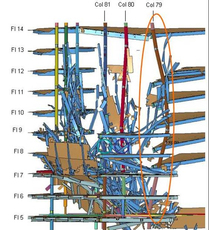Nov 24 2008
The National Institute of Standards and Technology (NIST) has released its final report on the Sept. 11, 2001, collapse of the 47-story World Trade Center building 7 (WTC 7) in New York City.
 Graphic showing the buckling of World Trade Center 7 Column 79 (circled area), the local failure identified as the initiating event in the building's progressive collapse
Graphic showing the buckling of World Trade Center 7 Column 79 (circled area), the local failure identified as the initiating event in the building's progressive collapse
The final report is strengthened by clarifications and supplemental text suggested by organizations and individuals worldwide in response to the draft WTC 7 report, released for public comment on Aug. 21, but the revisions did not alter the investigation team’s major findings and recommendations, which include identification of fire as the primary cause for the building’s failure.
The extensive three-year scientific and technical building and fire safety investigation found that the fires on multiple floors in WTC 7, which were uncontrolled but otherwise similar to fires experienced in other tall buildings, caused an extraordinary event. Heating of floor beams and girders caused a critical support column to fail, initiating a fire-induced progressive collapse that brought the building down.
In response to comments from the building community, NIST conducted an additional computer analysis. The goal was to see if the loss of WTC 7’s Column 79—the structural component identified as the one whose failure on 9/11 started the progressive collapse—would still have led to a complete loss of the building if fire or damage from the falling debris of the nearby WTC 1 tower were not factors. The investigation team concluded that the column’s failure under any circumstance would have initiated the destructive sequence of events.
Other revisions to the final WTC 7 report included:
- Expanding the discussion of firestopping, the material placed between floors to prevent floor-to-floor fire spread;
- Clarifying the description of thermal expansion as it related to WTC 7’s shear studs and floor beams; and
- Explaining in greater detail the computer modeling approach used to define where and when the fire in WTC 7 started and the extent of window breakage as a result of fire.
With the release of the final WTC 7 report, NIST has completed its federal building and fire safety investigation of the WTC disaster that began in August 2002. A three-year study of the collapses of the WTC towers (WTC 1 and 2) was completed in October 2005. More than 20 changes in the U.S. model building and fire codes have already been adopted based on the findings and recommendations from the investigation.
NIST will now work with various public and private groups toward implementing additional changes to the U.S. model building and fire codes including those based on the 13 recommendations from the WTC 7 report (one new and 12 reiterated from the towers investigation).
The complete text of the final WTC 7 report, a video describing the WTC 7 investigation findings, a of all comments received on the draft WTC 7 report, a chart tracking the progress toward implementing all of the NIST WTC recommendations, and other materials may be accessed at http://wtc.nist.gov.